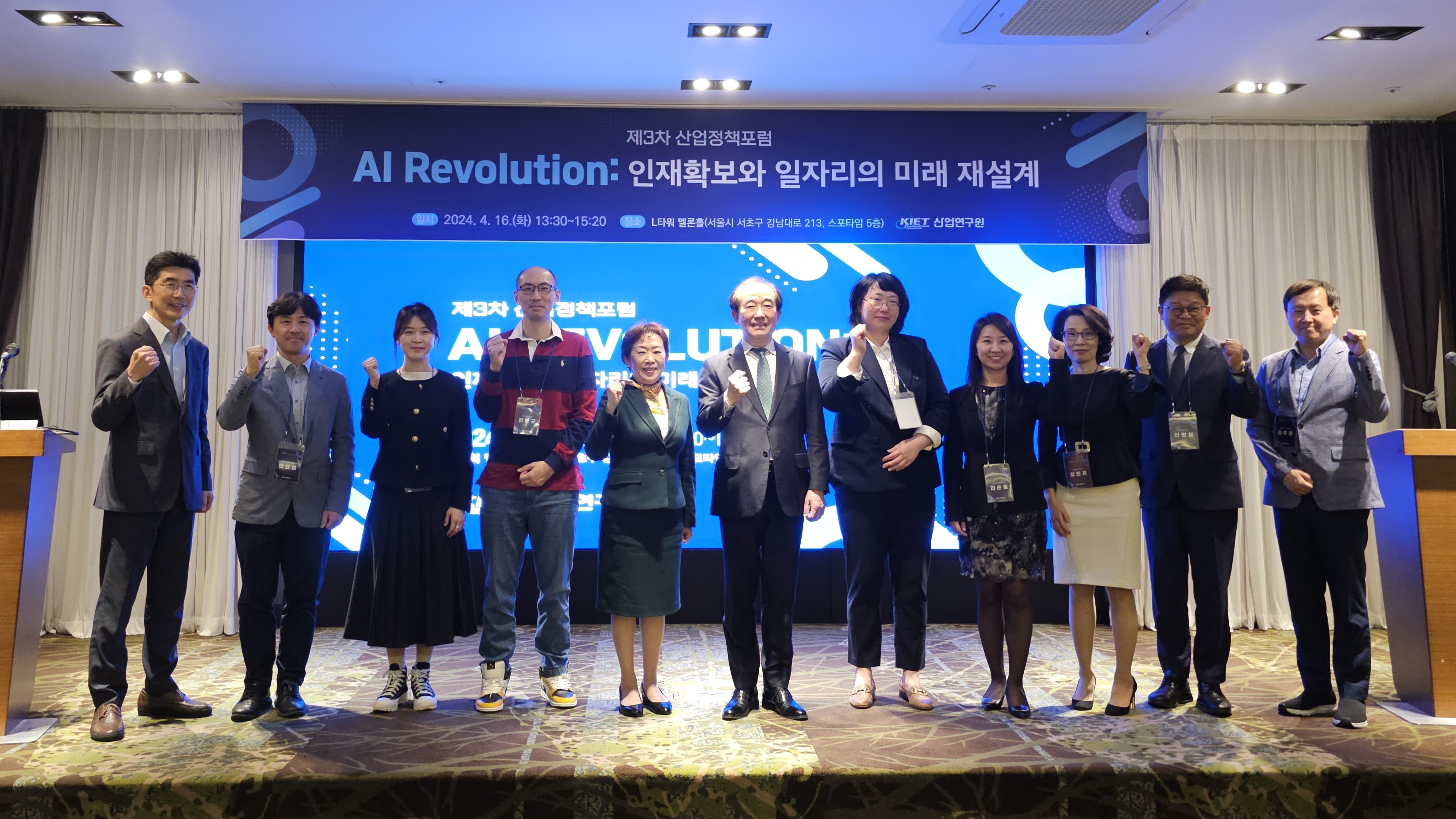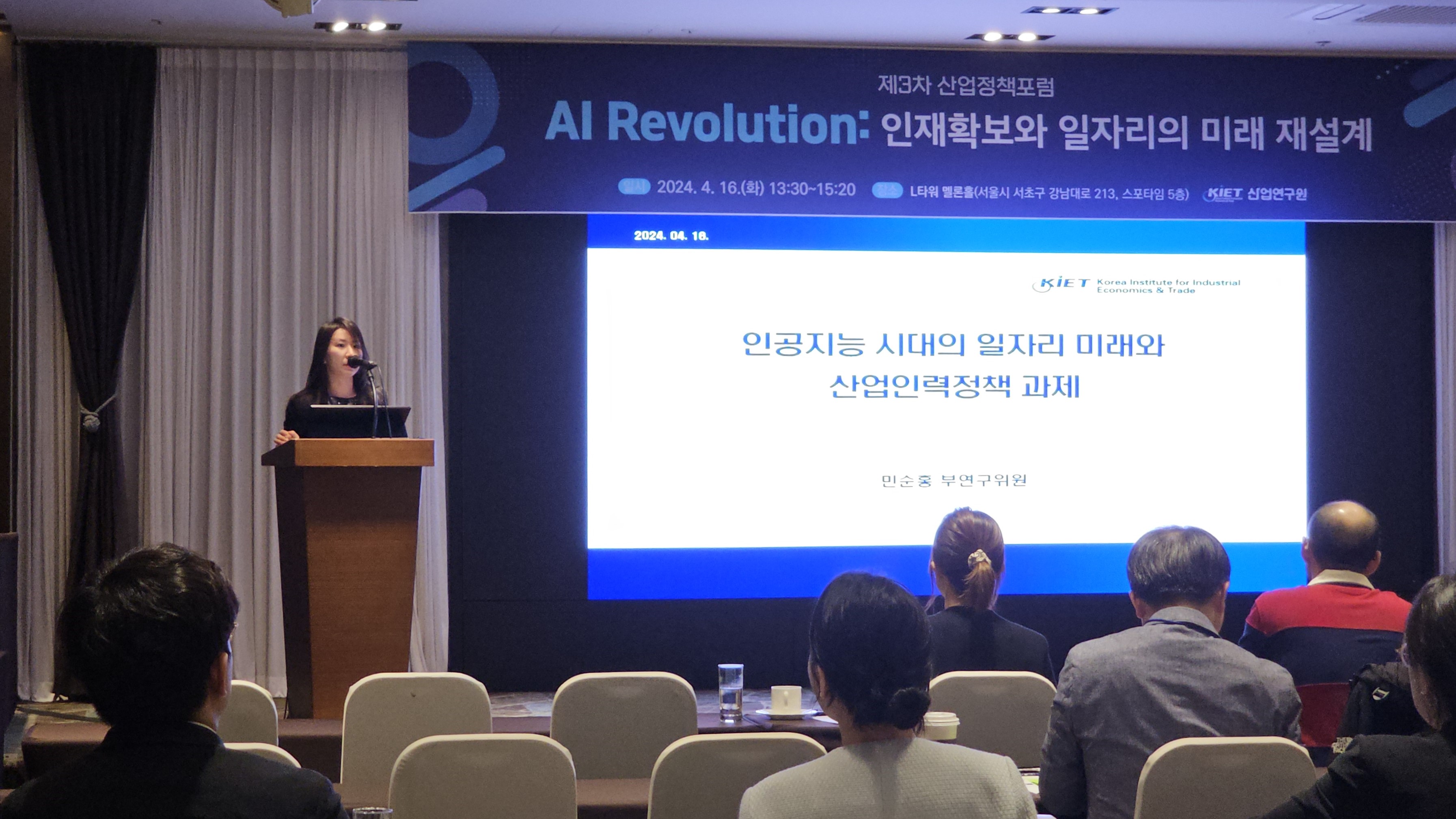인공지능 혁명이 산업 노동 구조 패러다임을 뒤흔들고 있다. 중숙련 노동자·전문가들의 소멸이 예고되는 가운데 미래 노동시장 개편에 따른 새로운 포지셔닝과 AI 기술 리딩을 위한 전문 인력 양성에 대한 논의들을 나누는 자리가 마련됐다.

▲제3차 산업정책포럼 발표자 및 패널, 관계자 등 기념사진
KIET, 3차 산업정책포럼 ‘AI 혁명’ 개최
AI 시대 중위시장 전문가·수요 소멸 예상
전문직 193만개 대체, 고급인력 구인은↑
인공지능 혁명이 산업 노동 구조 패러다임을 뒤흔들고 있다. 중숙련 노동자·전문가들의 소멸이 예고되는 가운데 미래 노동시장 개편에 따른 새로운 포지셔닝과 AI 기술 리딩을 위한 전문 인력 양성에 대한 논의들을 나누는 자리가 마련됐다.
산업연구원(KIET)에서 주최하는 제3차 산업정책포럼이 서울 양재 엘타워에서 16일 개최했다.
‘AI 혁명 : 인재확보와 일자리의 미래 재설계’를 주제로 열리는 이번 포럼은 AI 기술이 가져올 노동대체 양상과 이에 따른 필요역량을 전망하고 미래 산업인력정책이 해결해야 할 과제들에 대해서 논의하는 자리를 가졌다.
△길은선 산업연구원 연구위원의 AI 기술의 특이점과 핵심인재 인센티브 전략의 필요성 △민순홍 부연구위원의 인공지능 시대의 일자리 미래와 산업인력정책 과제를 비롯해 정보통신정책연구원, IGA Works, 고용노동부, 한국개발연구원 등이 참여한 종합토론이 함께 진행됐다.
주현 산업연구원 원장은 “최근 인공지능이 급격히 발전하며 사회·경제에 막대한 영향을 끼치며 우리가 배우고 가르치는 방식을 비롯해 상호작용하는 방식이 변화하는 가운데 이에 대한 대응책을 논의하는 자리이다”라고 말했다.
주 원장은 “직업 구조의 변화는 새로운 기회의 장임과 동시에 기존 일자리 소멸에 따른 사회적·경제적 도전을 해결해야 한다는 중대한 과제를 직면했다”고 말해 해결책 모색을 위한 자리 마련의 필요성을 강조했다.
민병주 한국산업기술진흥원 원장은 “주요국들이 AI 선점에 심혈을 기울이는 가운데 AI 연구 및 관련 제품·서비스를 개발할 우수 인재 유치에 각국이 다양한 수단을 강구하고 있다”라며 “우리 역시 골든타임을 놓쳐서는 안 되며 AI 시대 일자리 변화에 걸맞는 핵심인재 양성 방안을 논의하는 자리가 마련돼 뜻 깊은 시간이 되길 바란다”고 축사했다.
■ “AI 미래, 중위 전문가 시장 타격” 예상
.jpg)
▲길은선 연구위원
“화가·작곡가와 같은 예술 직업, 작가·편집자 등 문학·언어 전문가, 변회사·회계사 법률전문가, 요리사·영상제작자 등 창의적 기술 감독자와 같은 직업들은 인공지능 및 생성형 AI가 대체할 수 있을 것으로 최근 전망되고 있다”
과거에는 컴퓨터로 대체될 확률이 낮은 일자리를 창의성과 고급지능 요구하는 업무라고 예측했었다. 그러나 이제는 생성 AI가 창의적이고 전문 영역의 일들을 대체할 수 있을 것으로 우려되고 있는 실정이다.
길은선 연구위원은 AI 기술의 특이점과 핵심인재 인센티브 전략의 필요성에 대해 발표하면서 AI 기술은 노동시장 양극화가 아닌 동종업계 내 양극화를 야기할 것으로 예측했다.
하위시장은 소비자들이 AI 기술을 통해 직접 서비스 및 수요를 자체 해결하는 현상을 보일 것이며, 일반소비자 및 비전문가의 영역 확장이 두드러질 것으로 전망했다. 반면 고급 전문가 시장은 프랜차이즈형·슈퍼스타형 기업으로 성장해 AI를 통한 향상된 생산성을 기반으로 저렴하면서도 질 좋은 서비스를 대량 생산할 것으로 예측했다.
이러한 양극단의 시장 변화로 인해 중위 시장에서의 전문가 입지는 위축될 가능성이 점쳐졌다. 공급경쟁자 증가와 상위시장의 가격경쟁력 향상 및 인지도 우위에 기인해 노동시장의 양극화가 동종업계 내에서 발생할 수 있는 것이다.
이에 길은선 연구위원은 △신기술 조기 체화로 신시장 개척 모색 △직종 및 산업 변경을 유도하는 노동이동 및 재교육 정책 등의 방안 고려가 필요하다고 제언했다. 더불어 AI 기술 융복합 개발 역량을 지닌 SW 핵심인재들의 게임·가상화폐 분야 쏠림현상을 해결할 필요가 있어 AI 기술 발전을 견인하는 산업부문에 정부 주도 핵심인재 인센티브 전략을 고민해야 할 시기라고 지적했다.
■ AI, 전문직 193만개 대체...도입기엔 고급인력 구인 증가

▲민순홍 부연구위원
인공지능 대체 가능 일자리 327만개 가운데 전문직 193만개가 소멸 위험이 있는 것으로 예측됐다.
민순홍 부연구위원은 발제를 통해 △공학전문가 113만개 △정보통신전문가 55만개 등의 193만개 전문직이 AI에 의해 대체될 수 있을 것으로 전망된다며 국내 AI 도입률은 2022년 기준 △정보통신업 13.5% △금융업 9% △사업지원 서비스 7.2% 순으로 높았으며 아직 다른 산업에서는 도입율이 저조한 것으로 나타났다고 설명했다.
2022년 기준 국내인공지능 도입률은 평균 4% 수준으로 그마저도 종사자 수 1,000명 이상 및 매출 10조원 이상의 대기업에서 주로 채택하고 있다. 아직은 AI가 노동시장에 대체효과를 발휘하는 것보다는 도입기에서의 석박사급 고급인력 구인 증가를 견인하는 효과가 더 큰 것으로 나타나고 있는 추세이다.
현재 국내 AI 기술 성숙도는 초기 시작품 단계로 기업의 AI R&D 인력 채용 증가 추세와 75%의 AI 활용기업들이 자체 기술을 개발했다는 사실을 민 부연구위원은 언급했다.
그는 “미국이 전세계 AI 투자금을 모두 합쳐도 이를 뛰어넘을 만큼 민간부문에서 투자를 견인하고 있다”고 덧붙이며 △고숙련 전문인력 양성정책 정비 △해외인재유치 지원방안 검토 △민간투자·인력양성 활성화로 국가경쟁력 강화 등의 AI 인력양성 정책 보완·개선점을 제언했다.

.jpg)
